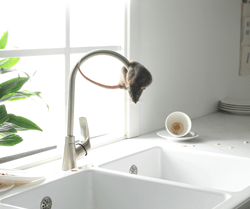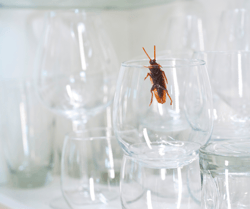Older homes have long been associated with housing unwelcome critters. The aging structures, porous materials, and lack of modern sealing techniques can make older homes understandably at risk for pest problems. However, as construction practices have advanced and building materials have been revamped, newer homes are protected from pest damage and infestations… or, so you may think.
Why do pests infest homes?
To determine if newer and older homes are equally at risk for pest activity, it’s vital to understand why pests are drawn to homes in the first place. Why are critters that are clearly intended to live life outdoors so insistent on ending up in our homes? Well, pests infest homes for a variety of reasons, primarily driven by their instinctual behaviors and the availability of favorable conditions. Understanding these factors can shed light on why pests choose to invade our living spaces and even help us take proactive measures to prevent infestations. Here are some key reasons why pests infest homes:
- Shelter and Protection: Like any living creature, pests seek shelter to escape harsh weather conditions, predators, and other external threats. Homes provide a secure and climate-controlled environment that offers protection from the elements, making them an attractive option for pests seeking safety.
- Food Sources: Pests are often drawn to homes by the promise of readily available food sources. Kitchens, pantries, and garbage cans can offer a buffet of sustenance for insects and rodents. Crumbs, spills, improperly stored food, and even pet food can all attract pests looking for an easy meal.
- Water: Pests, especially insects, require water to survive. Leaky pipes, dripping faucets, and even condensation in poorly ventilated areas can create a water source that pests eagerly exploit.
- Breeding Opportunities: Homes can provide pests with suitable conditions for breeding and multiplying. Dark, undisturbed corners, cluttered spaces, and hidden crevices offer ideal environments for pests to lay eggs and reproduce rapidly.
- Easy Access: Gaps, cracks, and openings in a home's structure can serve as entry points for pests. Insects can squeeze through tiny gaps, and rodents are skilled climbers that can exploit vulnerabilities in the building's exterior.
- Transportation: Pests can be inadvertently introduced into homes through items brought in from the outside, such as luggage, boxes, or even potted plants. Once inside, they can quickly establish themselves if the conditions are favorable.
- Warmth: Many pests are cold-blooded and rely on external heat sources to regulate their body temperature. Homes provide a stable and warm environment that supports the metabolic needs of these pests.
- Scent Trails: Pests often leave behind pheromone trails that attract others of their kind. This can lead to an infestation as pests follow these trails to a reliable food or shelter source.
- Natural Behavior: Some pests are naturally drawn to human habitats due to their ecological preferences. For example, certain species of ants are known to establish colonies near human settlements to take advantage of the food and shelter opportunities.
- Adaptability: Pests are remarkably adaptable creatures that can evolve and adjust to changing environments. As humans modify landscapes and structures, pests may exploit new opportunities that arise.
Overall, the reasons pests infest homes are complex and multifaceted but often are rooted in their innate drive for survival.
 Pests infest homes for various reasons, primarily driven by their instinctual behaviors.
Pests infest homes for various reasons, primarily driven by their instinctual behaviors.
Are older homes more at risk for pest activity than newer homes?
Generally speaking, older homes are more at risk for pest activity compared to newer homes. Several factors contribute to this increased susceptibility:
- Construction and Materials: Older homes often have more porous materials and structural vulnerabilities that pests can exploit. Gaps, cracks, and deteriorating wood can serve as entry points for insects and rodents.
- Aging Infrastructure: Plumbing and wiring in older homes may be outdated and prone to leaks or faults, creating moisture-rich environments that attract pests seeking water sources.
- Lack of Sealing: Modern construction techniques prioritize sealing gaps and cracks to prevent air leakage and improve energy efficiency. Older homes may lack proper sealing, allowing pests easier access.
- Less Stringent Building Codes: Building codes and regulations have become more stringent over time, requiring modern homes to meet higher standards for pest prevention during construction.
- Landscaping and Vegetation: Mature landscaping around older homes can provide pests with hiding spots and easy routes into the structure. Trees, shrubs, and other vegetation close to the house can facilitate pest movement.
- Decay and Dampness: As homes age, they are more prone to decay, which can create ideal conditions for pests that thrive in damp, decaying wood.
- Historical Pest Control Practices: Some older homes may have been treated with pesticides that are now banned or less effective, potentially leading to recurring pest problems.
- Inadequate Insulation: Older homes may have insufficient insulation, leading to temperature fluctuations that pests can exploit to find comfortable habitats.
However, it's important to note that newer homes are not entirely immune to pest issues. While modern construction techniques and materials can help reduce the risk of infestations, pests are adaptable and can still find ways to infiltrate even well-built structures. Factors such as local geography, climate, and homeowner practices also play a significant role in determining pest activity.
 Aging homes are ideal conditions for pests that thrive in damp, decaying wood.
Aging homes are ideal conditions for pests that thrive in damp, decaying wood.
Are newer homes protected from pests?
Newer homes are generally better equipped to withstand pest infestations than older homes, thanks to advancements in construction techniques, building materials, and pest prevention practices. However, it's important to understand that while newer homes are designed with pest prevention in mind, they are not entirely immune to pest issues. Here's why:
- Human Activities: Pests can be inadvertently introduced into homes through items like groceries, luggage, or used furniture. Even a small oversight can lead to a pest infestation.
- Construction Imperfections: Despite modern construction techniques, there can be gaps, cracks, or other vulnerabilities that pests exploit to gain entry.
- Landscaping and Exterior Factors: Surrounding landscaping, trees, shrubs, and vegetation can provide pathways for pests to enter the home. Poorly managed landscaping can create conducive conditions for pests.
- Environmental Changes: Changes in local weather patterns, temperature fluctuations, or shifts in nearby ecosystems can impact pest behavior and activity.
- Local Pest Populations: The prevalence of certain pests varies regionally, and even newer homes can be susceptible if they are in an area with a high pest population.
- Improper Maintenance: Neglecting routine maintenance tasks, such as cleaning, repairs, and sealing potential entry points, can increase the risk of pest infestations.
- Homeowner Practices: Improper food storage, inadequate waste disposal, and other practices that attract pests can contribute to infestations.
- Pest Adaptability: Pests are known for their ability to adapt and find ways to exploit new environments. Over time, pests might discover weaknesses or develop strategies to infiltrate newer homes.
In summary, while newer homes were built with pest protection in mind, they are still at risk of pest infestation and pest damage.
 New homes are often better equipped to withstand pest infestations.
New homes are often better equipped to withstand pest infestations.
Can my newly built home become infested by pests?
Yes! In fact, newer homes can potentially be more at risk for pest activity due to a false sense of protection. Homeowners of newer properties often assume that modern construction techniques and materials offer complete immunity against pests, leading them to neglect important preventive measures. This misconception can create an environment that inadvertently attracts pests and allows infestations to take root. Here's why this can happen:
- Complacency: The belief that a newer home is impervious to pests can lead to complacency in terms of pest prevention practices. Homeowners may not take the same precautions as they would in an older home.
- Lack of Awareness: New homeowners might not be as attuned to the signs of potential pest issues, delaying the detection and treatment of infestations.
- Misunderstanding Pest Behavior: Assuming that modern construction methods eliminate all vulnerabilities can lead to a lack of understanding about how pests can still exploit entry points, even in newer homes.
- Neglected Maintenance: Newer homes still require regular maintenance, including sealing gaps, keeping the home clean, and addressing potential pest attractants. Failing to do so can create opportunities for pests to thrive.
- Landscaping Oversights: Landscaping choices can impact pest activity around a home, regardless of its age. Neglecting proper landscaping practices can lead to increased pest presence.
- Unforeseen Factors: Environmental changes, fluctuations in local pest populations, or other unforeseen factors can affect pest behavior and lead to infestations in newer homes.
On the other hand, owners of older homes may expect to experience ongoing pest issues and take a more proactive approach to pest prevention as a result. In this way, an older home with a thorough pest prevention plan could be less likely to see a pest infestation compared to a new home with no preventative measures in place.
 New-build misconceptions can create an environment that inadvertently attracts pests and allows infestations.
New-build misconceptions can create an environment that inadvertently attracts pests and allows infestations.
Does building on undeveloped land disturb pests?
Yes, building a home on undeveloped land can potentially disturb pests and cause pest problems. When an area of land is disturbed for construction, it can disrupt the natural habitat and ecosystems that pests inhabit. This disturbance can lead to several issues:- Displacement of Pests: Construction activities such as clearing vegetation, excavating, and altering the landscape can force pests to migrate from their original habitats to new areas, including the newly built home. This can introduce pests such as springtails, ants, termites, beetles, and even rodents into the living spaces and cause infestations.
- Loss of Natural Predators: Construction can remove or disrupt the natural predators of pests, allowing pest populations to increase unchecked. For example, clearing trees and shrubs can remove bird and insect predators that help control pest populations.
- Changes in Environmental Conditions: Construction can alter the microclimates and environmental conditions of an area, creating new favorable conditions for pests. Pests that thrive in disturbed environments may find the new construction site suitable for breeding and survival.
- Access to Food and Shelter: Construction sites can create new sources of food and shelter for pests. Building materials, debris, and leftover food can attract pests like rodents, insects, and scavengers.
- Water Accumulation: Construction activities can lead to changes in water drainage patterns and the creation of stagnant water pools. Stagnant water can attract mosquitoes and other water-dependent pests.
 Building a home on undeveloped land can potentially lead to pest problems.
Building a home on undeveloped land can potentially lead to pest problems.
Can EcoShield Pest Solutions protect my new home from pests?
New, old, and anything in-between – EcoShield has got you covered. We highly recommend that homeowners of new-build homes enlist the help of a professional pest control company like EcoShield to protect their investment and ensure their new home stays pest-free now and in the future. Our Shield Home Protection Plan offers a comprehensive approach to pest management that focuses on the prevention of pests through the use of IPM or integrated pest management. Not only can we safeguard your home, but we can help treat existing infestations and offer solutions to keep your home pest-free in the future.
Give EcoShield a call or fill out the form on this page today to get started!
